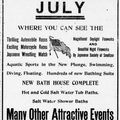If you don’t want to change your perspective, don’t go to Manzanar.
The road to Manzanar is breathtaking. The foot of the Sierras has the sort of terrain travelers stop to photograph, snow-dusted peaks and painter’s clouds. Highway 395 passes through 19th century California, pioneer mining towns with western false front buildings straight off a movie set. It’s a beautiful drive away from California’s urban coast and into the big empty.
And then, Manzanar. Nine miles past Lone Pine, a wooden watchtower pushes into the blue. My throat closes. The watchtower doesn’t belong here and never should have been here. Standing next to the base, it feels as though someone is looking down. It’s uncomfortable. In the 300 seconds I stand there, I hate it.
Try living under it, I think to myself.
That’s the point of Manzanar. To stand in a place that bears witness to the soul-wrenching history of people forced off the land and people forced on the land. It reminds us that those in power wield horrible, life-changing decisions. It reminds us to question, to not accept, that those in power always know better. It reminds us to speak up, because history repeats.
I take the chilly mile-walk from the visitors’ center through the camp to the cemetery. From a historian’s perspective, the cultural landscape of Manzanar is precious, something to protect fiercely in the generations ahead. I notice the walk also changes your posture, deep sand in places making it a little harder, the wind forcing your head down.
Years of that would have an effect.
A trail of pilgrims winds through the landscape to the cemetery’s iconic obelisk where people are gathering. There are graves, marked by stones. Taiko drums pull the crowd together like a collective heartbeat. The camp banners are brought out by people I know—my throat closes again—and a series of speakers connect the history of Manzanar to the present day.
Generational trauma, reminds the keynote speaker Dr. Satsuki Ina, is why places like Manzanar are the wound that never completely heals.
“Forced removal from our homes under armed guard, to an unknown destination. Imprisonment behind barbed wire, for an indefinite period of time, with thousands of other innocent people…” This, Dr. Ina explained, was a loss of control so massive and traumatic that it cannot simply be shaken off. Not once you’re free, not in a few years, not for generations. Why would anyone expect that?
Epigenetic scientists have referred to this legacy as the “ghost” in our genes. It is the shock and sadness that reverberates through generations until one day, this quiet hum increases in amplitude, and sings, loudly and others can hear it.
The 2015 Pilgrimage theme—Watashi wa Manzanar, “I am Manzanar”—struck me as intentional ownership, a way to reclaim the land and history to teach the lessons, to gather strength from each other, and to pass it on. It is not by coincidence that Japanese Americans reach out to disenfranchised communities.
Manzanar, along with the other confinement and detention centers, has become the steel within the soul, the song in the gene. After seven decades, new documents come to light, art and gardens are uncovered, and families come to Manzanar. They come, deliberately, to face history and to reconnect with those who understand without a word. In the crowd, there is undeniable warmth. Walking out into the desert to gain perspective, I look back at the pilgrims. I am struck, as I often have been working with people: they rarely know how beautiful they are.
By chance, we come across one of the National Park Service’s prominent archaeologists, Jeff Burton. He graciously walks us through the camp interior, pointing out restored gardens, lanterns, and ponds. I think about those who created places of beauty and solace from the stones cast at them. What would one create as a lifeline to humanity and normalcy when all seems lost? It makes the auction of art from the camps—the auction that almost happened prior to the Pilgrimage—all the more abhorrent.
That night, at Manzanar At Dusk—wind-blown from the day—the local high school gym is filled with pilgrims. There are college students connecting with older generations, diverse groups in intimate conversation, listening and asking questions, photographs pulled from the pages of a family album with a hopeful remark that maybe someone can help identify the faces. There is dancing and laughing. One young woman stands up to say the experience was life-changing. I believe most will come back.
I know I will.
I made the pilgrimage to Manzanar because my son’s ancestry includes Japanese, as well as my English, French, and Scots-Irish roots. His generation must use the ghost in the gene. I went because I am trying to save a Japanese pioneer property from demolition, a place that contains the horrific civil liberties history that Manzanar represents. I went to better understand the experience of forced evacuation and mass confinement, because words are inadequate for life-shattering events. To write, I had to walk the land, to absorb what I could by osmosis and conversation.
Now, I’ll never get Manzanar out of my head. But that’s entirely the point.
*This article was originally published on the Manzanar Committee blog, on May 5, 2015.
© 2015 Mary Adams Urashima






